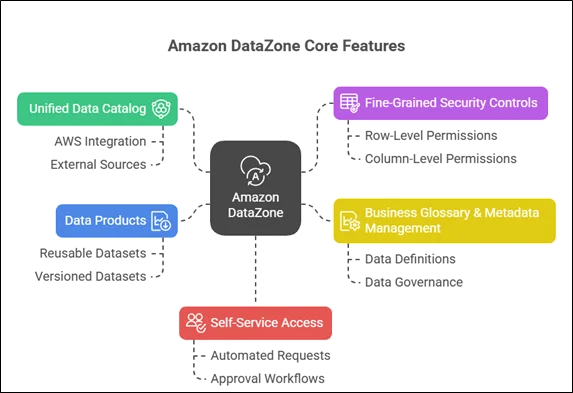|
Voiced by Amazon Polly |
Overview
Amazon DataZone simplifies enterprise data collaboration by unifying governance, access, and cataloging in a single service. It empowers organizations to discover, share, and trust their data assets securely, accelerating analytics and compliance readiness.
Pioneers in Cloud Consulting & Migration Services
- Reduced infrastructural costs
- Accelerated application deployment
Introduction
In today’s data-driven world, managing data across diverse teams, systems, and environments presents a significant challenge. Amazon DataZone, a flagship data management service from AWS, provides a powerful solution for centralizing, governing, and collaborating on data securely and efficiently. By breaking down silos and providing a unified platform for data discovery and governance, Amazon DataZone empowers organizations to transform raw data into trusted insights with speed and compliance.
Amazon DataZone

Amazon DataZone is a modern data management service that consolidates data assets from multiple sources into a governed, searchable catalog. Unlike traditional fragmented data ecosystems, it creates a centralized environment where data scientists, analysts, engineers, and business users can easily find, request access to, and collaborate on data relevant to their projects. With strong governance controls baked in, DataZone ensures that sensitive data remains protected while still enabling democratized, compliant access.
Core Features and Why They Matter

Unified Data Catalog
One of Amazon DataZone’s standout capabilities is its automated data cataloging. It integrates with AWS services like Amazon Redshift, Lake Formation, AWS Glue, and more, ingesting metadata to build a comprehensive catalog of data assets. This catalog supports multiple data formats and origins, including on-premises and third-party sources, breaking down traditional silos and providing one-stop searchability.
For example, a retail company can catalog data from sales, inventory, and customer feedback stored in disparate systems, giving marketing and product teams seamless data access for richer insights.
Fine-Grained Security Controls
Security is non-negotiable, especially when dealing with sensitive business or personal data. Amazon DataZone offers robust row-level and column-level security controls, enabling organizations to enforce policies with granular precision. This means that only authorized users can view sensitive fields or records, ensuring compliance with regulations such as GDPR, HIPAA, or industry-specific mandates.
Consider a healthcare research scenario: patient data can be tightly governed so that researchers access only anonymized or aggregated data, thereby preserving privacy while not hindering innovation.
Business Glossaries and Metadata Management
Amazon DataZone promotes data literacy and trust by providing shared business glossaries and enforcing metadata standards. Glossaries unify the meaning of terms across teams, for instance, ensuring ‘active customer’ has a consistent definition between sales and support departments. Automated metadata checks prevent inconsistent or incomplete data descriptions, raising data quality and user confidence.
Data Products
Amazon DataZone introduces the concept of data products, curated bundles of datasets and associated metadata created for specific analytical use cases. Teams across an organization can subscribe to these data products, which are versioned and governed, making data reuse straightforward and reliable without the need for repeated data wrangling.
Self-Service Data Access
By offering a simple data portal, Amazon DataZone enables end users to search for data, submit access requests, and receive approvals through automated workflows based on business policies. This automation drastically reduces bottlenecks, empowering teams to move faster in their analytics or product efforts without compromising on governance.
A Practical Use Case: Accelerating E-Commerce Analytics
Imagine an online retailer aiming to improve its customer experience by leveraging data from sales transactions, website interactions, and customer service logs. Historically, these datasets exist in isolated systems, with slow processes for requesting and approving access that frustrate analysts.

With Amazon DataZone:
- The company catalogs all these datasets into a shared, searchable space with detailed metadata.
- Analysts easily discover unified customer datasets and submit access requests through Amazon DataZone’s portal.
- Policies automatically grant access to anonymized sales and interaction data, protecting customer privacy.
- Analysts combine these datasets into a data product aligned with their campaign goals and subscribe to it.
- Marketing teams quickly derive insights on purchasing trends and customer preferences, enabling faster campaign iterations and personalization.
Implementation Steps: A High-Level Roadmap

- Assessment and Governance Strategy – Identify key data owners, crucial datasets, and compliance needs. Sketch out governance policies defining who can access what data and under which circumstances. Engage business and technical stakeholders early.
- Environment Setup – Establish the Amazon DataZone domain within your AWS account. Integrate existing data repositories, such as Amazon Redshift, Amazon S3, and AWS Lake Formation, and configure identity and access management (IAM) roles or AWS Identity and Access Management (IAM) for authentication.
- Data Onboarding and Cataloging – Start ingesting datasets into Amazon DataZone’s catalog. Tag assets with metadata and assign ownership. Define business glossaries collaboratively to ensure semantic consistency.
- Policy Definition and Automation – Create fine-grained access control policies, subscription request workflows, and auditing rules. Implement automated enforcement of metadata requirements for assets being published.
- User Enablement and Adoption – Deliver training sessions for both administrators and data consumers. Promote the self-service portal and showcase practical scenarios to drive adoption.
- Optimization and Expansion – Monitor usage patterns, refine policies for better governance and ease of use, and onboard additional datasets or domains progressively.
Conclusion
Amazon DataZone is a comprehensive solution bridging the gap between governance, collaboration, and efficiency in modern data management. By providing a centralized, secured, and self-service data ecosystem, it addresses the pain points of slow data access, fragmented governance, and compliance risks. Organizations adopting DataZone benefit from faster insights, deeper data trust, and a unified approach to data-driven innovation.
Whether improving customer analytics, enabling compliant healthcare research, or supporting financial reporting, Amazon DataZone empowers businesses to unlock the full potential of their data in a scalable, secure, and practical manner.
Drop a query if you have any questions regarding Amazon DataZone and we will get back to you quickly.
Making IT Networks Enterprise-ready – Cloud Management Services
- Accelerated cloud migration
- End-to-end view of the cloud environment
About CloudThat
CloudThat is an award-winning company and the first in India to offer cloud training and consulting services worldwide. As a Microsoft Solutions Partner, AWS Advanced Tier Training Partner, and Google Cloud Platform Partner, CloudThat has empowered over 850,000 professionals through 600+ cloud certifications winning global recognition for its training excellence including 20 MCT Trainers in Microsoft’s Global Top 100 and an impressive 12 awards in the last 8 years. CloudThat specializes in Cloud Migration, Data Platforms, DevOps, IoT, and cutting-edge technologies like Gen AI & AI/ML. It has delivered over 500 consulting projects for 250+ organizations in 30+ countries as it continues to empower professionals and enterprises to thrive in the digital-first world.
FAQs
1. What problem does Amazon DataZone solve for enterprises?
ANS: – Amazon DataZone addresses the challenge of fragmented data management by unifying data discovery, sharing, and governance across multiple systems. It enables teams to securely access and collaborate on trusted data, reducing silos and accelerating analytics.
2. How does Amazon DataZone ensure data security and compliance?
ANS: – It enforces fine-grained, row- and column-level access controls, ensuring that only authorized users can view sensitive information. Built-in governance workflows and audit trails enable organizations to maintain compliance with regulations such as GDPR and HIPAA.
3. Who benefits most from using Amazon DataZone?
ANS: – Amazon DataZone supports data engineers, analysts, and business users alike. Engineers can publish and document datasets, administrators can define governance policies, and business users can independently discover and access curated data products through a self-service portal.

WRITTEN BY Sana Pathan
Sana Pathan is the Head of Infra, Security & Migrations at CloudThat and also leads the Managed Services and FinOps verticals. She holds 7x AWS and Azure certifications, spanning professional and specialty levels, demonstrating deep expertise across multiple cloud domains. With extensive experience delivering solutions for customers in diverse industries, Sana has been instrumental in driving successful cloud migrations, implementing advanced security frameworks, and optimizing cloud costs through FinOps practices. By combining technical excellence with transparent communication and a customer-centric approach, she ensures organizations achieve secure, efficient, and cost-effective cloud adoption and operations.


 Login
Login


 October 16, 2025
October 16, 2025 PREV
PREV










Comments